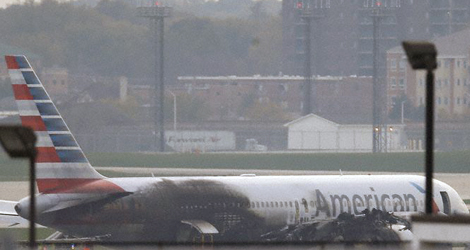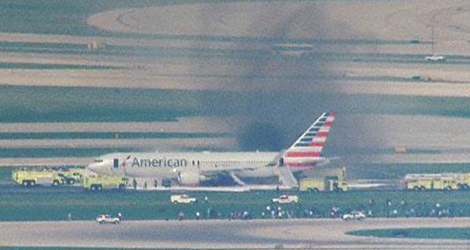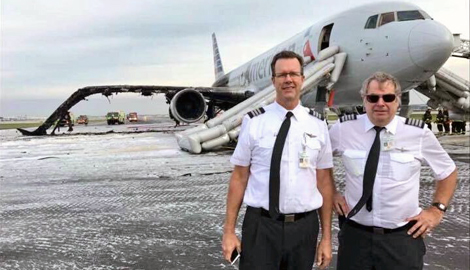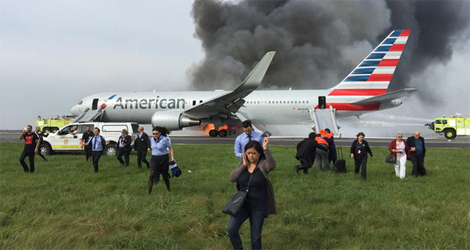American Airlines flight AA383 , from Chicago O’Hare to Miami, FL , operated with a Boeing B767-300 (N-345AN) stopped on the runway during takeoff roll, caught fire and evacuated the passengers.
American Airlines flight AA383 had 161 passengers and 9 crew on board, during the evacuation seven passengers and one flight attendant received minor injures and were taken to hospitals.
source : Aviation Accident Database youtube channel ©
During the takeoff roll on runway 28R in Chicago O’Hare, at 14:50 Local Time (19:50Z) , the crew of American Airlines flight AA383 rejected takeoff at high speed reporting “stopping on the runway“.
Tower acknowledged adding the word “Fire”.
A large fire was seen from the right hand wing of American Airlines flight AA383 with a plume of smoke.
Evacuation on the runway was carried out via slides. Fuselage skin of the airplane melted , most of it is burned and the aircraft has substantial damage.

American Airlines – Boeing B767-300 (N-345AN) flight AA383
Findings and conclusions :
- The flight crew of American Airlines flight AA383 was properly certificated and qualified in accordance with federal regulations and company requirements. A review of the flight crew’s work and sleep schedules and recent activities showed no evidence of factors that could have adversely affected the performance of either crewmember on the day of the accident.
- The airplane was properly certificated, equipped, and maintained in accordance with federal regulations. No evidence indicated any structural, engine, or system failures before the uncontained engine failure occurred.
- The right engine experienced an uncontained high-pressure turbine (HPT) stage 2 disk rupture during the takeoff roll.
The HPT stage 2 disk of American Airlines flight AA383 initially separated into two fragments. One fragment penetrated through the inboard section of the right wing, severed the main engine fuel feed line, breached the fuel tank, traveled up and over the fuselage, and landed about 3,000 ft away. The other fragment exited outboard of the right engine, impacting the runway and fracturing into three pieces.

American Airlines flight AA383
- The high-pressure turbine stage 2 disk failed because of multiple low-cycle fatigue cracks that initiated from an internal material anomaly, known as a discrete dirty white spot, which formed during the processing of the material from which the disk was manufactured.
- The discrete dirty white spot was most likely not detectable by the inspection methods used during production of the high-pressure turbine stage 2 disk.
- Additional Federal Aviation Administration and industry efforts are needed to determine if enhanced ultrasonic inspection methods are a best practice for inspecting nickel parts during manufacturing.
- The fatigue cracks that initiated from the discrete dirty white spot were not detectable at the time of the high-pressure turbine stage 2 disk’s last inspection using the surface-based inspection techniques mandated by the applicable airworthiness directive.
- If a subsurface inspection technique, such as an ultrasonic inspection, had been required at the time of the high-pressure turbine stage 2 disk’s last inspection, the cracks that developed from the discrete dirty white spot of American Airlines flight AA383 should have been detectable because of the size of the cracks at that time and the sensitivity of ultrasonic inspection techniques.
- Future aircraft certification efforts would benefit from guidance on uncontained engine failure debris models and resulting design mitigations that is based on lessons learned from recent in-service events.
-

American Airlines flight AA383
The captain of American Airlines flight AA383 made a timely decision to reject the takeoff and performed the maneuver in accordance with company training and procedures.
- The captain’s decision to perform the engine fire checklist was appropriate given his training, the information provided by air traffic control, and the fire warnings in the cockpit.
- Engine fire checklists that specifically address ground operations would allow a flight crew to secure an engine and command an evacuation, if required, in a timelier manner than engine fire checklists that do not differentiate between ground and in-flight operations.
- The flight attendants of American Airlines flight AA383 made a good decision to begin the evacuation given the fire on the right side of the airplane and the smoke in the cabin, but the left overwing exit should have been blocked while the left engine was still operating because of the increased risk of injury to passengers who evacuated from that exit.
- If the flight crew or the flight attendants had communicated after the airplane came to a stop, the flight crew could have become aware of the severity of the fire on the right side of the airplane and the need to expeditiously shut down the engines.
- American Airlines did not adequately train flight attendants qualified on the Boeing 767 to effectively use the different interphone system models installed on the airplane during an emergency.
- The Federal Aviation Administration’s inadequate actions to improve guidance and training on communication and coordination between flight and cabin crews during emergency situations, including evacuations, could lead to negative consequences for the traveling public if this safety issue continues to be unresolved.
- The flight crewmembers and flight attendants did not coordinate in an optimal manner once the passengers were evacuated.
- Evidence of passengers retrieving carry-on baggage during this and other recent emergency evacuations demonstrates that previous Federal Aviation Administration actions to mitigate this potential safety hazard have not been effective.

pilots of American Airlines flight AA383 posing after the event.
The National Transportation Safety Board determines that the probable cause of this accident was the failure of the high-pressure turbine (HPT) stage 2 disk, which severed the main engine fuel feed line and breached the right main wing fuel tank, releasing fuel that resulted in a fire on the right side of the airplane during the takeoff roll.
The HPT stage 2 disk failed because of low-cycle fatigue cracks that initiated from an internal subsurface manufacturing anomaly that was most likely not detectable during production inspections and subsequent in-service inspections using the procedures in place. Contributing to the serious passenger injury was (1) the delay in shutting down the left engine and (2) a flight attendant’s deviation from company procedures, which resulted in passengers evacuating from the left overwing exit while the left engine was still operating.
Contributing to the delay in shutting down the left engine was (1) the lack of a separate checklist procedure for Boeing 767 airplanes that specifically addressed engine fires on the ground and (2) the lack of communication between the flight and cabin crews after the airplane came to a stop.
Download Report


0 Comments